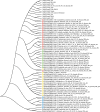From Q Fever to Coxiella burnetii Infection: a Paradigm Change
- PMID: 27856520
- PMCID: PMC5217791
- DOI: 10.1128/CMR.00045-16
From Q Fever to Coxiella burnetii Infection: a Paradigm Change
Abstract
Coxiella burnetii is the agent of Q fever, or "query fever," a zoonosis first described in Australia in 1937. Since this first description, knowledge about this pathogen and its associated infections has increased dramatically. We review here all the progress made over the last 20 years on this topic. C. burnetii is classically a strict intracellular, Gram-negative bacterium. However, a major step in the characterization of this pathogen was achieved by the establishment of its axenic culture. C. burnetii infects a wide range of animals, from arthropods to humans. The genetic determinants of virulence are now better known, thanks to the achievement of determining the genome sequences of several strains of this species and comparative genomic analyses. Q fever can be found worldwide, but the epidemiological features of this disease vary according to the geographic area considered, including situations where it is endemic or hyperendemic, and the occurrence of large epidemic outbreaks. In recent years, a major breakthrough in the understanding of the natural history of human infection with C. burnetii was the breaking of the old dichotomy between "acute" and "chronic" Q fever. The clinical presentation of C. burnetii infection depends on both the virulence of the infecting C. burnetii strain and specific risks factors in the infected patient. Moreover, no persistent infection can exist without a focus of infection. This paradigm change should allow better diagnosis and management of primary infection and long-term complications in patients with C. burnetii infection.
Keywords: Coxiella burnetii; Q fever; diagnosis; epidemiology; genomics; treatment.
Copyright © 2016 American Society for Microbiology.
Figures














References
-
- Delsing CE, Kullberg BJ, Bleeker-Rovers CP. 2010. Q fever in the Netherlands from 2007 to 2010. Neth J Med 68:382–387. - PubMed
Publication types
MeSH terms
LinkOut - more resources
Full Text Sources
Other Literature Sources

